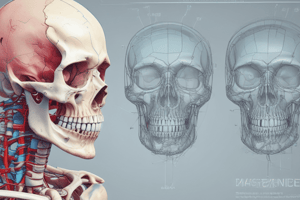Podcast
Questions and Answers
When is a scanogram taken during a standard diagnostic computed tomography of the urinary tract?
When is a scanogram taken during a standard diagnostic computed tomography of the urinary tract?
- As the final step of the procedure
- After administering i.v. contrast
- Before the scan process begins (correct)
- Before obtaining venous access
What phase are the scans obtained in approximately 70 seconds after i.v. contrast administration during computed tomography of the urinary tract?
What phase are the scans obtained in approximately 70 seconds after i.v. contrast administration during computed tomography of the urinary tract?
- Interstitial phase
- Nephrogenic phase
- Excretory phase
- Arterial phase (correct)
What is one of the indications for performing computed tomography of the urinary tract?
What is one of the indications for performing computed tomography of the urinary tract?
- Evaluation of renal stone disease (correct)
- Assessment of pulmonary function
- Diagnosis of skin infections
- Investigation of thyroid nodules
Which of the following is NOT a possible use of computed tomography angiography in the assessment of renal vessels?
Which of the following is NOT a possible use of computed tomography angiography in the assessment of renal vessels?
When performing computed tomography urinary tract examination, what is used to assess precontrast attenuation and enhancement patterns in the kidneys?
When performing computed tomography urinary tract examination, what is used to assess precontrast attenuation and enhancement patterns in the kidneys?
In which position does the patient lie during a standard diagnostic computed tomography for renal tract malignancy?
In which position does the patient lie during a standard diagnostic computed tomography for renal tract malignancy?
Which of the following criteria indicates a benign adrenal lesion on a delayed contrast-enhanced CT scan?
Which of the following criteria indicates a benign adrenal lesion on a delayed contrast-enhanced CT scan?
What is the primary purpose of performing an unenhanced CT scan in adrenal lesion characterization?
What is the primary purpose of performing an unenhanced CT scan in adrenal lesion characterization?
What is the recommended technique for a CT scan of the kidneys, ureters, and bladder (CT KUB) to assess renal tract calculus disease?
What is the recommended technique for a CT scan of the kidneys, ureters, and bladder (CT KUB) to assess renal tract calculus disease?
In a computed tomography urogram (CTU), what is the purpose of the oral water load given before the intravenous contrast injection?
In a computed tomography urogram (CTU), what is the purpose of the oral water load given before the intravenous contrast injection?
During a computed tomography urogram (CTU), at what time point is the nephrographic/parenchymal enhancement phase scan typically acquired?
During a computed tomography urogram (CTU), at what time point is the nephrographic/parenchymal enhancement phase scan typically acquired?
What is the primary limitation of a low-dose CT KUB scan without intravenous or oral contrast?
What is the primary limitation of a low-dose CT KUB scan without intravenous or oral contrast?
Flashcards are hidden until you start studying
Study Notes
Scanogram timing
- A scanogram is taken at the beginning of a standard diagnostic computed tomography (CT) of the urinary tract, before contrast is administered.
Nephrographic Phase
- The nephrographic phase of a CT scan of the urinary tract is obtained approximately 70 seconds after intravenous contrast administration.
Indications for CT Urinary Tract
- One indication for performing a computed tomography of the urinary tract is to evaluate for suspected renal tract malignancy.
CT Angiography Uses
- CT angiography is not used to assess for renal artery stenosis, as it is not as sensitive or specific for this purpose compared to other methods like magnetic resonance angiography (MRA).
CT KUB Assessment
- CT KUB examinations use pre-contrast attenuation and enhancement patterns in the kidneys to assess for potential pathologies such as renal masses or cysts.
Patient Position
- During a standard diagnostic CT for renal tract malignancy, the patient lies in a supine position on the scanning table.
Benign Adrenal Lesions
- On a delayed contrast-enhanced CT scan, a benign adrenal lesion typically demonstrates a low Hounsfield unit (HU) value, indicating a lack of significant contrast enhancement.
Unenhanced CT Scan Purpose
- Performing an unenhanced CT scan of adrenal lesions is primarily used to assess the size and density of the lesion, as well as to identify any calcifications within the lesion, aiding in the initial characterization.
Recommended Technique for CT KUB
- The recommended technique for a CT KUB scan to assess for renal tract calculus disease involves performing a thin-section (1-2mm) scan through the kidneys, ureters, and bladder, with both pre-contrast and post-contrast image acquisition to optimize visualization of stones.
Oral Water Load in CTU
- Providing an oral water load before intravenous contrast injection in a computed tomography urogram (CTU) is essential to distend the urinary bladder, allowing for optimal visualization of the bladder and lower urinary tract, enhancing the diagnostic accuracy for detecting potential issues like bladder stones or tumors.
Nephrographic Phase Acquisition
- The nephrographic/parenchymal enhancement phase scan during a CTU is typically acquired around 60-90 seconds after intravenous contrast administration, as this timing provides optimal visualization of the renal parenchyma due to contrast enhancement.
Limitations of Low-Dose CT KUB
- A low-dose CT KUB scan without intravenous or oral contrast can be limited in its ability to detect small calculi (stones) or subtle abnormalities in the urinary tract. The lack of contrast limits visualization of the intricate anatomy and subtle pathology.
Studying That Suits You
Use AI to generate personalized quizzes and flashcards to suit your learning preferences.




